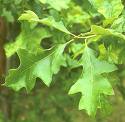Cherrybark Oak Tree Information
Images of Cherrybark Oak:






Cherrybark Oak grows in the following 23 states and provinces:
Alabama, Arkansas, Delaware, Florida, Georgia, Illinois, Indiana, Kentucky, Louisiana, Maryland, Mississippi, Missouri, New Jersey, New York, North Carolina, Ohio, Oklahoma, Pennsylvania, South Carolina, Tennessee, Texas, Virginia, West VirginiaInformation about Cherrybark Oak:
The Quercus Falcata is commonly known as the Bottomland Red Oak, Cherrybark Oak, Elliott Oak, Southern Red Oak, Swamp Red Oak as well as Swamp Spanish Oak.
The currently accepted scientific name for southern red oak is Quercus falcata Michx. . Cherrybark oak was once classified as a variety of southern red oak . It is now classified as a distinct species, Quercus pagoda Raf. . The leaves of southern red oak are polymorphic . Cherrybark oak is distinguished from southern red oak by leaf shape and vast differences in site preference . Southern red oak and cherry bark oak hybridize with the following species : x Q. ilicifolia (bear oak): Q. X. caesariensis Moldenke x Q. imbricaria (shingle oak): Q. X. anceps Palmer x Q. incana (bluejack oak): Q. X. subintegra Trel. x Q. laevis (turkey oak): Q. X. blufftonensis Trel. x Q. laurifolia (laurel oak): Q. X. beaumontiana Sarg. x Q. nigra (water oak): Q. X. garlandensis Palmer x Q. phellos (willow oak): Q. X. ludoviciana Sarg. x Q. velutina (black oak): Q. X. wildenowiana (Dipple) Zabel, Q. X. pinetorum Moldenke x Q. marilandicaSouthern red oak is widespread in the southeastern United States from Long Island, New York, south to Florida, west to the Brazos River in eastern Texas and north into eastern Oklahoma, Arkansas, southern Illinois, southern Ohio, and western West Virginia. It occurs only on the coast in the North Atlantic States and primarily on the Piedmont in the South Atlantic States . It is found occasionally on uplands of the Blue Ridge Province from Virginia south to Georgia . Cherrybark oak occurs on the coastal plains from southeastern Virginia to northwestern Florida and west to the 45 inch (114 cm) rainfall line in east Texas . Although rare in the lower delta, it grows north in the Mississippi River valley. Unlike the typical variety, cherrybark oak is absent from eastern Tennessee, eastern Kentucky, and West Virginia . In Florida, this variety occurs only on the floodplain of the Apalachicola River in Jackson and Gadsen counties .Southern red oak frequently occurs in transitional communities between midslope hardwood forests and upland pine (Pinus spp.) forests . In Florida, southern red oak occurs on the more mesic, fertile upland longleaf pine (P. palustris) savannas in place of bluejack and turkey oaks . In Texas, southern red oak may be dominant in the pineywoods and the post oak (Quercus stellata) savanna communities . Cherrybark oak may codominate with pin oak (Q. palustris) in Illinois . The swamp chestnut oak (Q. michauxii)-cherrybark oak forest cover type is located topographically higher and on better drained sites than the willow oak-water oak-laurel oak type . The following published classifications list southern red oak as a dominant or codominant species: Eastern deciduous forest The natural communities of South Carolina Forest vegetation of the Big Thicket, southeast Texas Successional and environmental relationships of the forest vegetation of north-central Florida